2007 CHEVROLET CORVETTE warning light
[x] Cancel search: warning lightPage 352 of 488
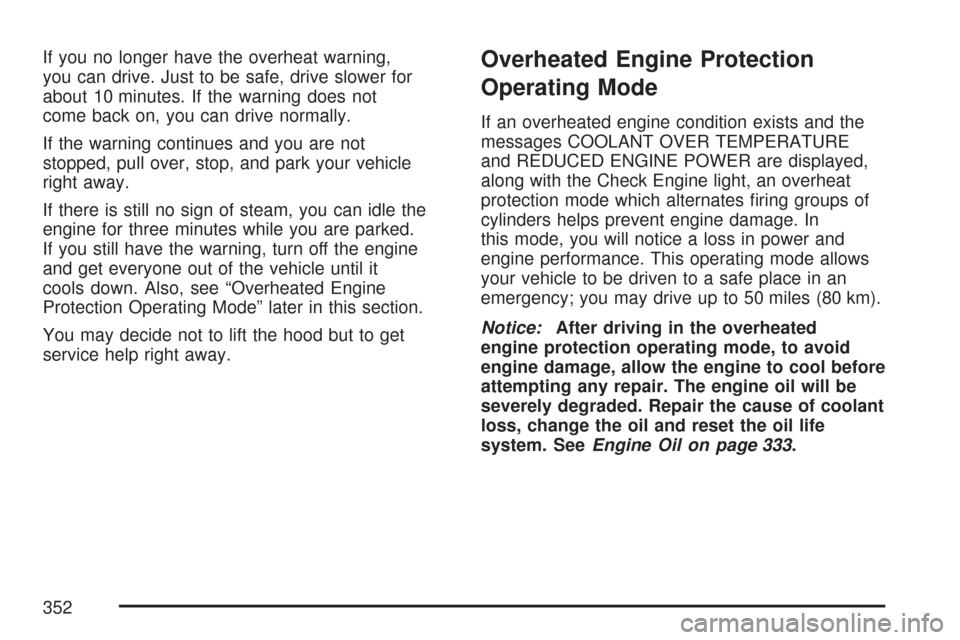
If you no longer have the overheat warning,
you can drive. Just to be safe, drive slower for
about 10 minutes. If the warning does not
come back on, you can drive normally.
If the warning continues and you are not
stopped, pull over, stop, and park your vehicle
right away.
If there is still no sign of steam, you can idle the
engine for three minutes while you are parked.
If you still have the warning, turn off the engine
and get everyone out of the vehicle until it
cools down. Also, see “Overheated Engine
Protection Operating Mode” later in this section.
You may decide not to lift the hood but to get
service help right away.Overheated Engine Protection
Operating Mode
If an overheated engine condition exists and the
messages COOLANT OVER TEMPERATURE
and REDUCED ENGINE POWER are displayed,
along with the Check Engine light, an overheat
protection mode which alternates �ring groups of
cylinders helps prevent engine damage. In
this mode, you will notice a loss in power and
engine performance. This operating mode allows
your vehicle to be driven to a safe place in an
emergency; you may drive up to 50 miles (80 km).
Notice:After driving in the overheated
engine protection operating mode, to avoid
engine damage, allow the engine to cool before
attempting any repair. The engine oil will be
severely degraded. Repair the cause of coolant
loss, change the oil and reset the oil life
system. SeeEngine Oil on page 333.
352
Page 363 of 488
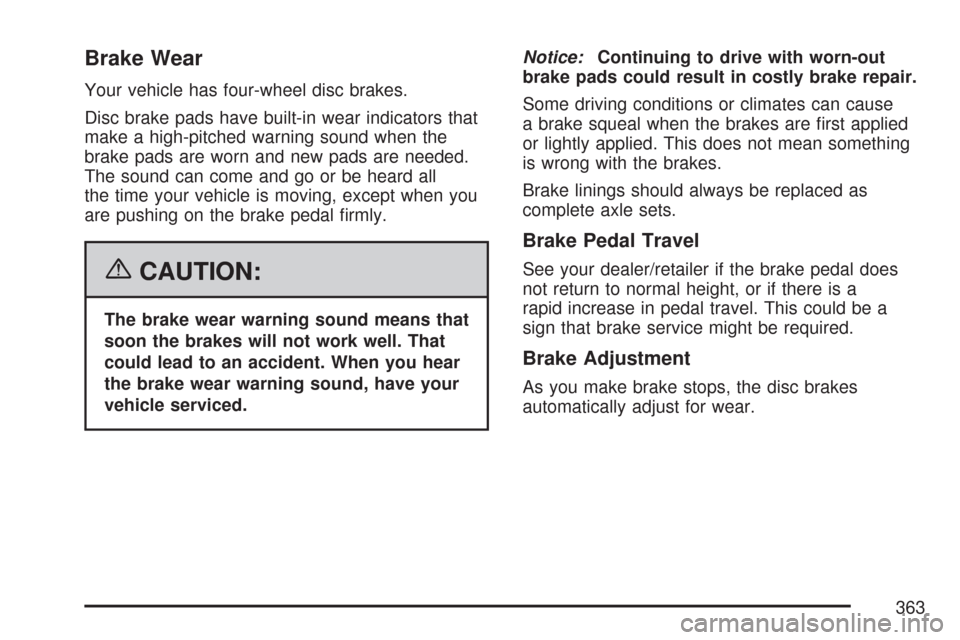
Brake Wear
Your vehicle has four-wheel disc brakes.
Disc brake pads have built-in wear indicators that
make a high-pitched warning sound when the
brake pads are worn and new pads are needed.
The sound can come and go or be heard all
the time your vehicle is moving, except when you
are pushing on the brake pedal �rmly.
{CAUTION:
The brake wear warning sound means that
soon the brakes will not work well. That
could lead to an accident. When you hear
the brake wear warning sound, have your
vehicle serviced.Notice:Continuing to drive with worn-out
brake pads could result in costly brake repair.
Some driving conditions or climates can cause
a brake squeal when the brakes are �rst applied
or lightly applied. This does not mean something
is wrong with the brakes.
Brake linings should always be replaced as
complete axle sets.
Brake Pedal Travel
See your dealer/retailer if the brake pedal does
not return to normal height, or if there is a
rapid increase in pedal travel. This could be a
sign that brake service might be required.
Brake Adjustment
As you make brake stops, the disc brakes
automatically adjust for wear.
363
Page 389 of 488
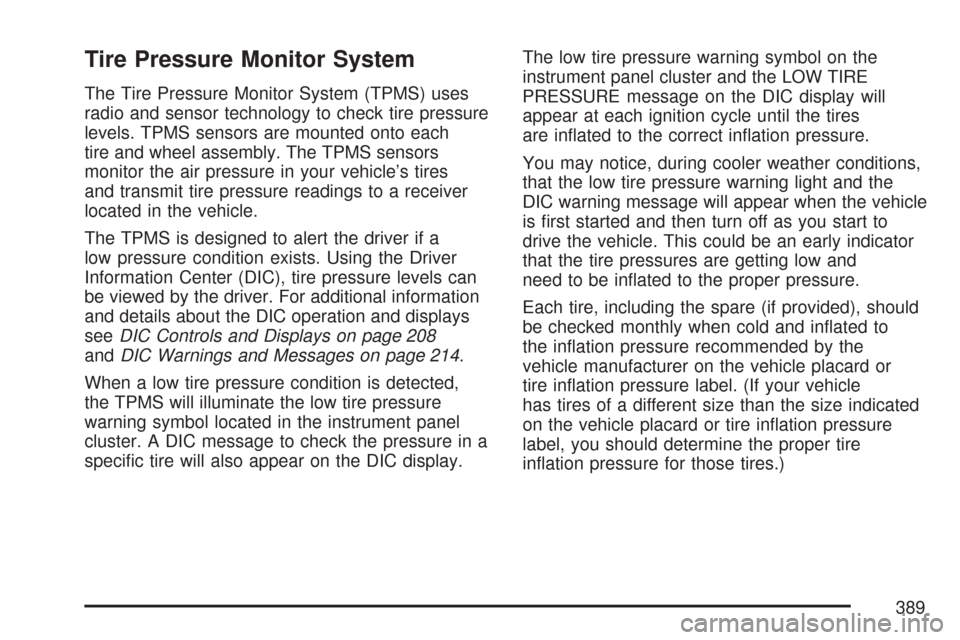
Tire Pressure Monitor System
The Tire Pressure Monitor System (TPMS) uses
radio and sensor technology to check tire pressure
levels. TPMS sensors are mounted onto each
tire and wheel assembly. The TPMS sensors
monitor the air pressure in your vehicle’s tires
and transmit tire pressure readings to a receiver
located in the vehicle.
The TPMS is designed to alert the driver if a
low pressure condition exists. Using the Driver
Information Center (DIC), tire pressure levels can
be viewed by the driver. For additional information
and details about the DIC operation and displays
seeDIC Controls and Displays on page 208
andDIC Warnings and Messages on page 214.
When a low tire pressure condition is detected,
the TPMS will illuminate the low tire pressure
warning symbol located in the instrument panel
cluster. A DIC message to check the pressure in a
speci�c tire will also appear on the DIC display.The low tire pressure warning symbol on the
instrument panel cluster and the LOW TIRE
PRESSURE message on the DIC display will
appear at each ignition cycle until the tires
are in�ated to the correct in�ation pressure.
You may notice, during cooler weather conditions,
that the low tire pressure warning light and the
DIC warning message will appear when the vehicle
is �rst started and then turn off as you start to
drive the vehicle. This could be an early indicator
that the tire pressures are getting low and
need to be in�ated to the proper pressure.
Each tire, including the spare (if provided), should
be checked monthly when cold and in�ated to
the in�ation pressure recommended by the
vehicle manufacturer on the vehicle placard or
tire in�ation pressure label. (If your vehicle
has tires of a different size than the size indicated
on the vehicle placard or tire in�ation pressure
label, you should determine the proper tire
in�ation pressure for those tires.)
389
Page 397 of 488
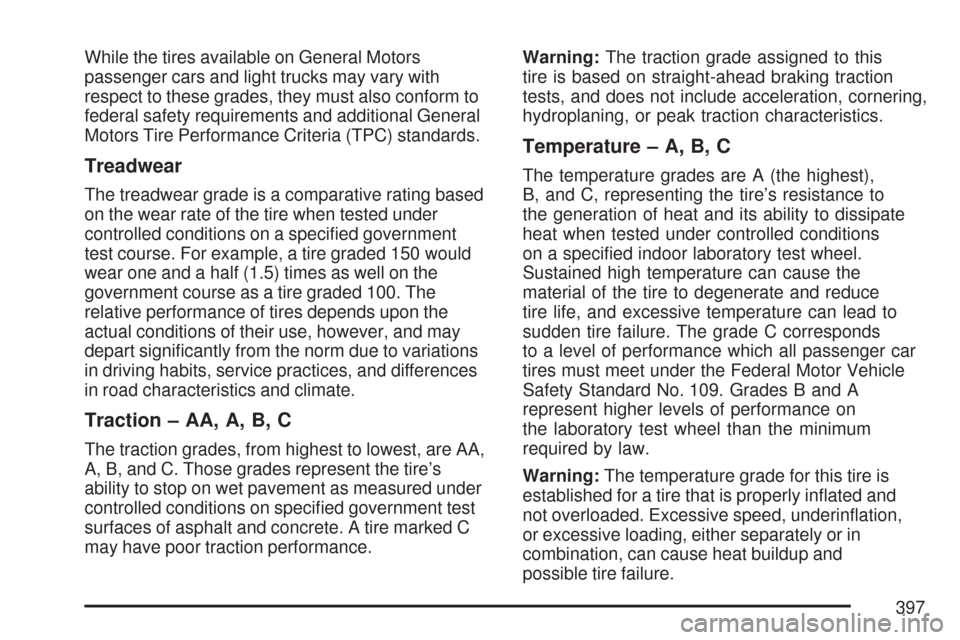
While the tires available on General Motors
passenger cars and light trucks may vary with
respect to these grades, they must also conform to
federal safety requirements and additional General
Motors Tire Performance Criteria (TPC) standards.
Treadwear
The treadwear grade is a comparative rating based
on the wear rate of the tire when tested under
controlled conditions on a speci�ed government
test course. For example, a tire graded 150 would
wear one and a half (1.5) times as well on the
government course as a tire graded 100. The
relative performance of tires depends upon the
actual conditions of their use, however, and may
depart signi�cantly from the norm due to variations
in driving habits, service practices, and differences
in road characteristics and climate.
Traction – AA, A, B, C
The traction grades, from highest to lowest, are AA,
A, B, and C. Those grades represent the tire’s
ability to stop on wet pavement as measured under
controlled conditions on speci�ed government test
surfaces of asphalt and concrete. A tire marked C
may have poor traction performance.Warning:The traction grade assigned to this
tire is based on straight-ahead braking traction
tests, and does not include acceleration, cornering,
hydroplaning, or peak traction characteristics.
Temperature – A, B, C
The temperature grades are A (the highest),
B, and C, representing the tire’s resistance to
the generation of heat and its ability to dissipate
heat when tested under controlled conditions
on a speci�ed indoor laboratory test wheel.
Sustained high temperature can cause the
material of the tire to degenerate and reduce
tire life, and excessive temperature can lead to
sudden tire failure. The grade C corresponds
to a level of performance which all passenger car
tires must meet under the Federal Motor Vehicle
Safety Standard No. 109. Grades B and A
represent higher levels of performance on
the laboratory test wheel than the minimum
required by law.
Warning:The temperature grade for this tire is
established for a tire that is properly in�ated and
not overloaded. Excessive speed, underin�ation,
or excessive loading, either separately or in
combination, can cause heat buildup and
possible tire failure.
397
Page 473 of 488
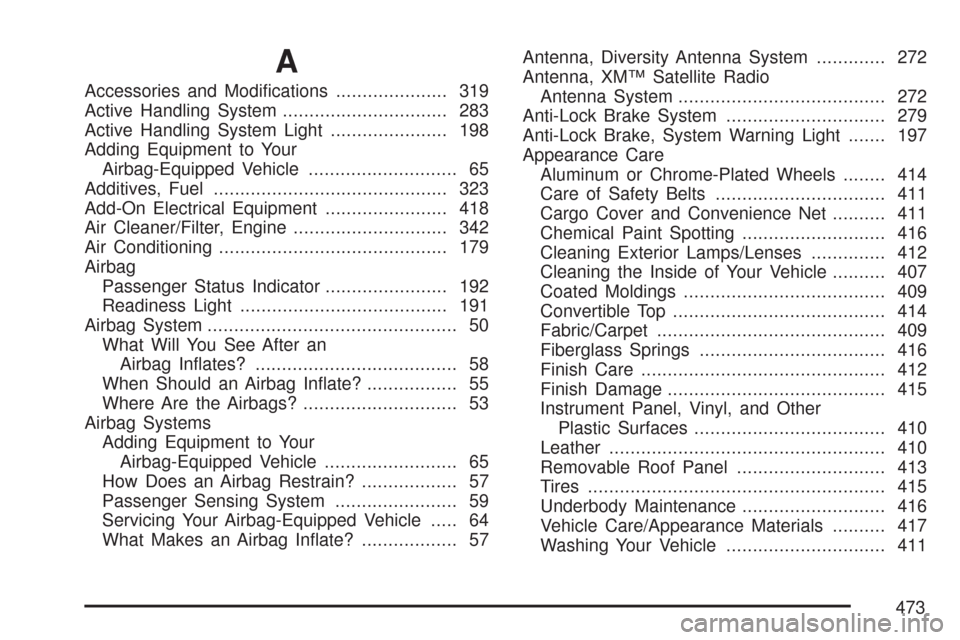
A
Accessories and Modi�cations..................... 319
Active Handling System............................... 283
Active Handling System Light...................... 198
Adding Equipment to Your
Airbag-Equipped Vehicle............................ 65
Additives, Fuel............................................ 323
Add-On Electrical Equipment....................... 418
Air Cleaner/Filter, Engine............................. 342
Air Conditioning........................................... 179
Airbag
Passenger Status Indicator....................... 192
Readiness Light....................................... 191
Airbag System............................................... 50
What Will You See After an
Airbag In�ates?...................................... 58
When Should an Airbag In�ate?................. 55
Where Are the Airbags?............................. 53
Airbag Systems
Adding Equipment to Your
Airbag-Equipped Vehicle......................... 65
How Does an Airbag Restrain?.................. 57
Passenger Sensing System....................... 59
Servicing Your Airbag-Equipped Vehicle..... 64
What Makes an Airbag In�ate?.................. 57Antenna, Diversity Antenna System............. 272
Antenna, XM™ Satellite Radio
Antenna System....................................... 272
Anti-Lock Brake System.............................. 279
Anti-Lock Brake, System Warning Light....... 197
Appearance Care
Aluminum or Chrome-Plated Wheels........ 414
Care of Safety Belts................................ 411
Cargo Cover and Convenience Net.......... 411
Chemical Paint Spotting........................... 416
Cleaning Exterior Lamps/Lenses.............. 412
Cleaning the Inside of Your Vehicle.......... 407
Coated Moldings...................................... 409
Convertible Top........................................ 414
Fabric/Carpet........................................... 409
Fiberglass Springs................................... 416
Finish Care.............................................. 412
Finish Damage......................................... 415
Instrument Panel, Vinyl, and Other
Plastic Surfaces.................................... 410
Leather.................................................... 410
Removable Roof Panel............................ 413
Tires........................................................ 415
Underbody Maintenance........................... 416
Vehicle Care/Appearance Materials.......... 417
Washing Your Vehicle.............................. 411
473
Page 474 of 488
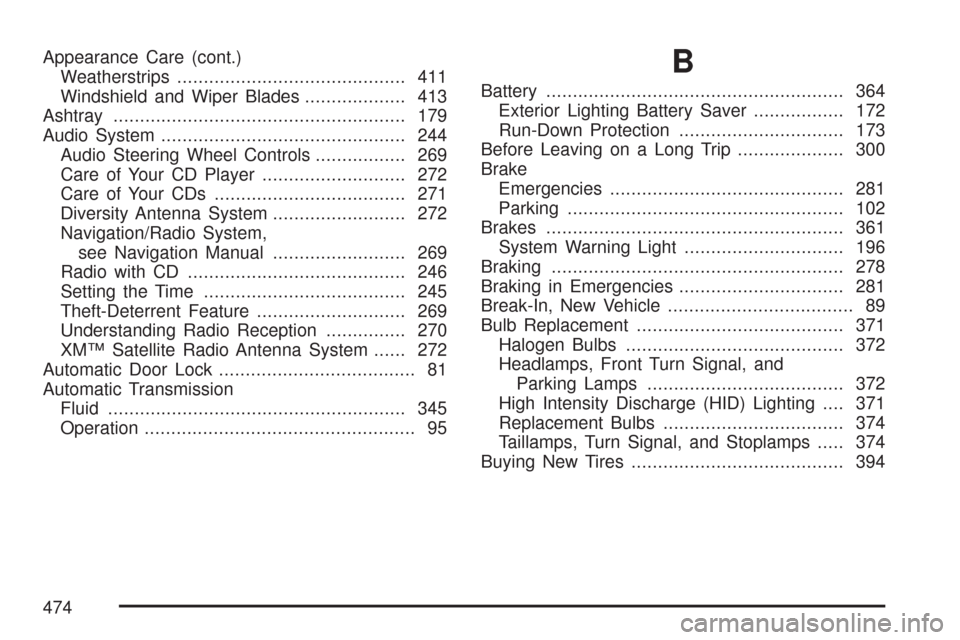
Appearance Care (cont.)
Weatherstrips........................................... 411
Windshield and Wiper Blades................... 413
Ashtray....................................................... 179
Audio System.............................................. 244
Audio Steering Wheel Controls................. 269
Care of Your CD Player........................... 272
Care of Your CDs.................................... 271
Diversity Antenna System......................... 272
Navigation/Radio System,
see Navigation Manual......................... 269
Radio with CD......................................... 246
Setting the Time...................................... 245
Theft-Deterrent Feature............................ 269
Understanding Radio Reception............... 270
XM™ Satellite Radio Antenna System...... 272
Automatic Door Lock..................................... 81
Automatic Transmission
Fluid........................................................ 345
Operation................................................... 95B
Battery........................................................ 364
Exterior Lighting Battery Saver................. 172
Run-Down Protection............................... 173
Before Leaving on a Long Trip.................... 300
Brake
Emergencies............................................ 281
Parking.................................................... 102
Brakes........................................................ 361
System Warning Light.............................. 196
Braking....................................................... 278
Braking in Emergencies............................... 281
Break-In, New Vehicle................................... 89
Bulb Replacement....................................... 371
Halogen Bulbs......................................... 372
Headlamps, Front Turn Signal, and
Parking Lamps..................................... 372
High Intensity Discharge (HID) Lighting.... 371
Replacement Bulbs.................................. 374
Taillamps, Turn Signal, and Stoplamps..... 374
Buying New Tires........................................ 394
474
Page 475 of 488
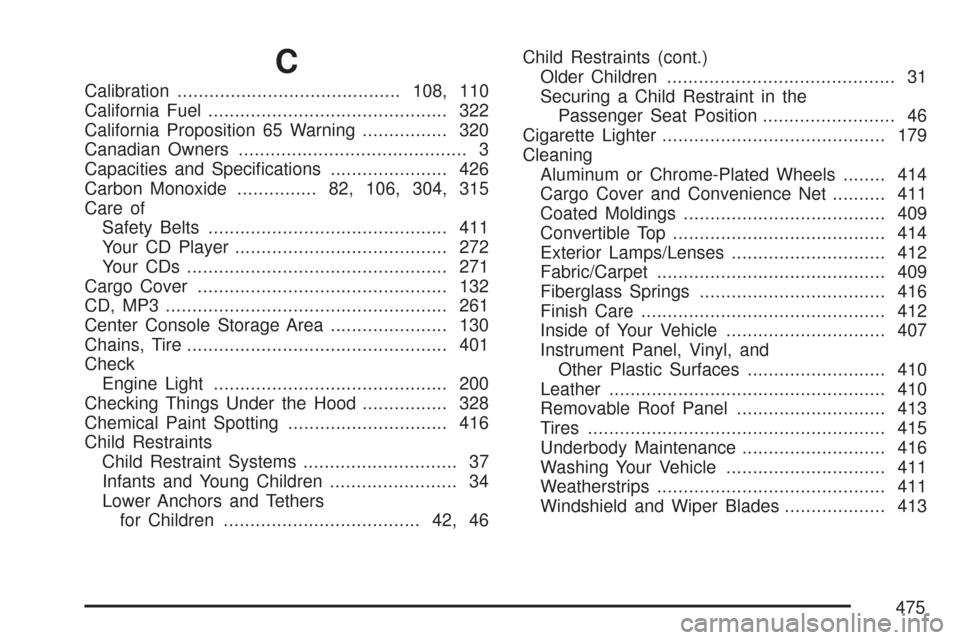
C
Calibration..........................................108, 110
California Fuel............................................. 322
California Proposition 65 Warning................ 320
Canadian Owners........................................... 3
Capacities and Speci�cations...................... 426
Carbon Monoxide............... 82,106, 304, 315
Care of
Safety Belts............................................. 411
Your CD Player........................................ 272
Your CDs ................................................. 271
Cargo Cover............................................... 132
CD, MP3 ..................................................... 261
Center Console Storage Area...................... 130
Chains, Tire................................................. 401
Check
Engine Light............................................ 200
Checking Things Under the Hood................ 328
Chemical Paint Spotting.............................. 416
Child Restraints
Child Restraint Systems............................. 37
Infants and Young Children........................ 34
Lower Anchors and Tethers
for Children..................................... 42, 46Child Restraints (cont.)
Older Children........................................... 31
Securing a Child Restraint in the
Passenger Seat Position......................... 46
Cigarette Lighter.......................................... 179
Cleaning
Aluminum or Chrome-Plated Wheels........ 414
Cargo Cover and Convenience Net.......... 411
Coated Moldings...................................... 409
Convertible Top........................................ 414
Exterior Lamps/Lenses............................. 412
Fabric/Carpet........................................... 409
Fiberglass Springs................................... 416
Finish Care.............................................. 412
Inside of Your Vehicle.............................. 407
Instrument Panel, Vinyl, and
Other Plastic Surfaces.......................... 410
Leather.................................................... 410
Removable Roof Panel............................ 413
Tires........................................................ 415
Underbody Maintenance........................... 416
Washing Your Vehicle.............................. 411
Weatherstrips........................................... 411
Windshield and Wiper Blades................... 413
475
Page 478 of 488
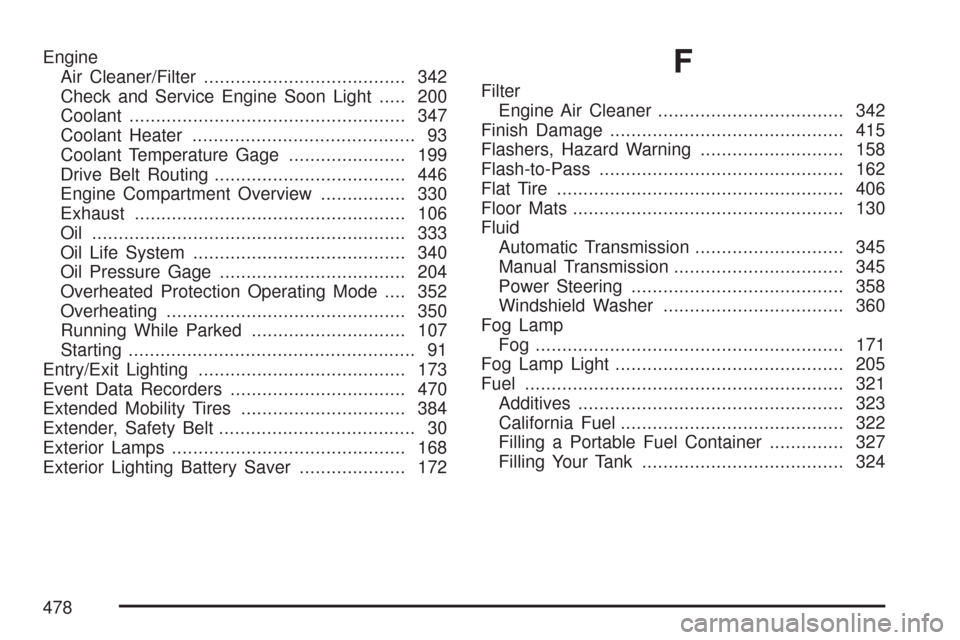
Engine
Air Cleaner/Filter...................................... 342
Check and Service Engine Soon Light..... 200
Coolant.................................................... 347
Coolant Heater.......................................... 93
Coolant Temperature Gage...................... 199
Drive Belt Routing.................................... 446
Engine Compartment Overview................ 330
Exhaust................................................... 106
Oil ........................................................... 333
Oil Life System........................................ 340
Oil Pressure Gage................................... 204
Overheated Protection Operating Mode.... 352
Overheating............................................. 350
Running While Parked............................. 107
Starting...................................................... 91
Entry/Exit Lighting....................................... 173
Event Data Recorders................................. 470
Extended Mobility Tires............................... 384
Extender, Safety Belt..................................... 30
Exterior Lamps............................................ 168
Exterior Lighting Battery Saver.................... 172F
Filter
Engine Air Cleaner................................... 342
Finish Damage............................................ 415
Flashers, Hazard Warning........................... 158
Flash-to-Pass.............................................. 162
Flat Tire...................................................... 406
Floor Mats................................................... 130
Fluid
Automatic Transmission............................ 345
Manual Transmission................................ 345
Power Steering........................................ 358
Windshield Washer.................................. 360
Fog Lamp
Fog .......................................................... 171
Fog Lamp Light........................................... 205
Fuel............................................................ 321
Additives.................................................. 323
California Fuel.......................................... 322
Filling a Portable Fuel Container.............. 327
Filling Your Tank...................................... 324
478